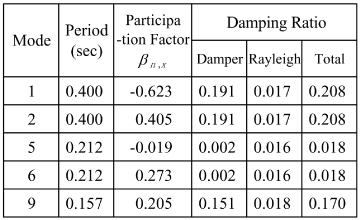

MANUSCRIPT FORMAT GUIDELINES:
THIRD INTERNATIONAL CONFERENCE ON URBAN EARTHQUAKE ENGINEERING
K.Kasai 1), E.F.Cruz 2), and K.Kawashima 3)
1) Professor, Structural Engineering Research Center, Tokyo Institute
of Technology, Japan
2) Professor, Dept. of Structural and Geotechnical Engineering, Catholic
University of Chile, Santiago, Chile
3) Professor, Department of Civil Engineering, Tokyo Institute of Technology,
Japan
kasai@serc.titech.ac.jp,
ecruz@ing.puc.cl, kawasima@cv.titech.ac.jp
Abstract: This document describes format instructions for the
papers to be presented at Third
International Conference on Urban Earthquake Engineering. It is our
goal to be relatively flexible in the
format, yet maintaining a reasonable degree of consistency between papers
in the finished product.
This document is formatted in a desired manner, and the authors are
expected to use it as a template.
1. INTRODUCTION
Second International Conference on Urban Earthquake Engineering will
be held on March 6-7,
2006 at Suzukakedai Campus, Tokyo Institute of Technology, Yokohama,
Japan. This document
describes, and is formatted in, a required style of the conference paper.
After final review, accepted papers will be included in the proceeding
volume. Printed volume and
its CD version will be made available during the conference. The electronic
copy of the final paper
must be sent to the conference office (address: conf@cuee.titech.ac.jp)
by February 13, 2006.
2. FORMAT REQUIREMENTS
2.1 Word ProcessingThe author must submit two different types of electronic copies: a file created by Word 2000 or
later version, and a PDF file created by ADOBE Acrobat 4.0 or later version. This document is a Word
2000 template, and the author may type directly on this file. The author using other word processors
may submit a PDF file only, but the paper must meet the format requirements in Section 2.2.
2.2 Details of Required Format
Authors must follow the format details given in this section.
1. Paper Size and Length: 6 to 8 pages (A4 size sheet, 210mm x 297 mm).
2. Margins: 25 mm (1.0 inch) top and bottom, 20 mm (0.8 inch) on sides.
3. Default Font Type, Size, and Line Spacing: 12 pt size Times New Roman
with 14 pt line spacing,
justified on both margins, unless otherwise specified. All "blank
lines" are also in this format.
4. Title: Four blank lines from top of the first page, then a line with
the paper title in 14 pt size bold,
centered, small caps. If two lines are needed, use 18 pt line spacing
between them.
5. Author's Name: Two blank lines after the title, then a line with
the author name(s) in bold.
6. Author's Position and Affiliation: Two blank lines after the author's
name, then a line with the
position and affiliation per author in 10 pt size italics and 12 pt
line spacing. This should be
repeated for multiple authors.
7. E-mail address(es): A line with the author e-mail address(es) in
10 pt size italics and 12 pt line spacing.
8. Abstract: A 100-200 word abstract in 10 pt size and 12 pt line spacing,
left and right indented 10 mm
each.
9. Section Headings: Two blank lines after the previous section, 12
pt size bold, capital letters.
10. Section Subheadings: One blank line after the previous subsection,
12 pt size bold.
11. Body text: 12 pt size and 14 pt line spacing, justified on both
margins. First line of each
paragraph is indented by 4 blank characters.
12. Figures: Insert in text where appropriate, with a caption centered
below the figure, as shown on next
page. Use 10 pt size and 12 pt line spacing for the caption.
13. Tables: As with Figures, but with caption centered above the table.
14. Equations: Centered, with equation number set flush at the right
margin, one blank line above and
below.
15. Units: SI units are required.
16. References: References such as journal papers, conference papers,
and books should appear as shown
below. Use 10 pt size and 12 pt line spacing. Citations in the text
of the paper should use author last
names and the year; for example, "… in previous work by the authors
(Kasai et al. 1998, MacRae and
Kawashima 2001)" or "… as shown in the work by Kasai et
al. (1998) and MacRae and Kawashima
(2001)." Additionally, authors are responsible for obtaining
permission for reprinting any material
included in their papers that is already copyrighted elsewhere.
3. CONCLUSIONS
If you have any questions concerning these format instructions, please
contact the conference
office (address: conf@cuee.titech.ac.jp).
Acknowledgements:
The authors acknowledge support from Japan Ministry of Education, Culture,
Sport, Science, and
Technology (MEXT) for establishing the Center for Urban Earthquake Engineering
(CUEE) in Tokyo Institute
of Technology. The support has made possible this international conference,
as well as international joint
research projects and exchange programs with foreign universities.
References:
Newmark, N.M. and Rosenblueth, E. (1971), "Fundamentals of Earthquake
Engineering," Prentice-Hall Inc.
Trifunac, M.D. and Brady, A.G. (1975), "A Study on Duration of
Strong Earthquake Ground Motion," Bulletin
of the Seismological Society of America, 65(3), 581-626.
Kasai, K., Fu, Y., and Watanabe, A. (1998), "Passive Control Systems
for Seismic Damage Mitigation,"
Journal of Structural Engineering, American Society of Civil
Engineers, 124(5), 501-512.
MacRae, G. A. and Kawashima, K. (2001),"Seismic Behavior of Hollowed
Stiffened Steel Bridge Columns,"
Journal of Bridge Engineering, American Society of Civil Engineers,
6(2), 110-119.
Fujimoto, K. and Midorikawa, S. (2000), "Simplified Method for
Predicting Ground Motion Intensity Map
Considering Effect of Irregular Deep Underground Structure," Proceedings
of the 6th International
Conference on Seismic Zonation, Paper No. 2-23B.
An example for an equation is given by Eq. (1) below:
![]()
Also, figure and table examples are given in Figure 1 and Table 1 below:

Figure 1 Vibration Modes of Space Frame with Dampers: (a) 1st Mode,
and (b) 6th Mode
Table 1 Periods, Participation Factors, and Damping Ratios of Space
Frame with Dampers

